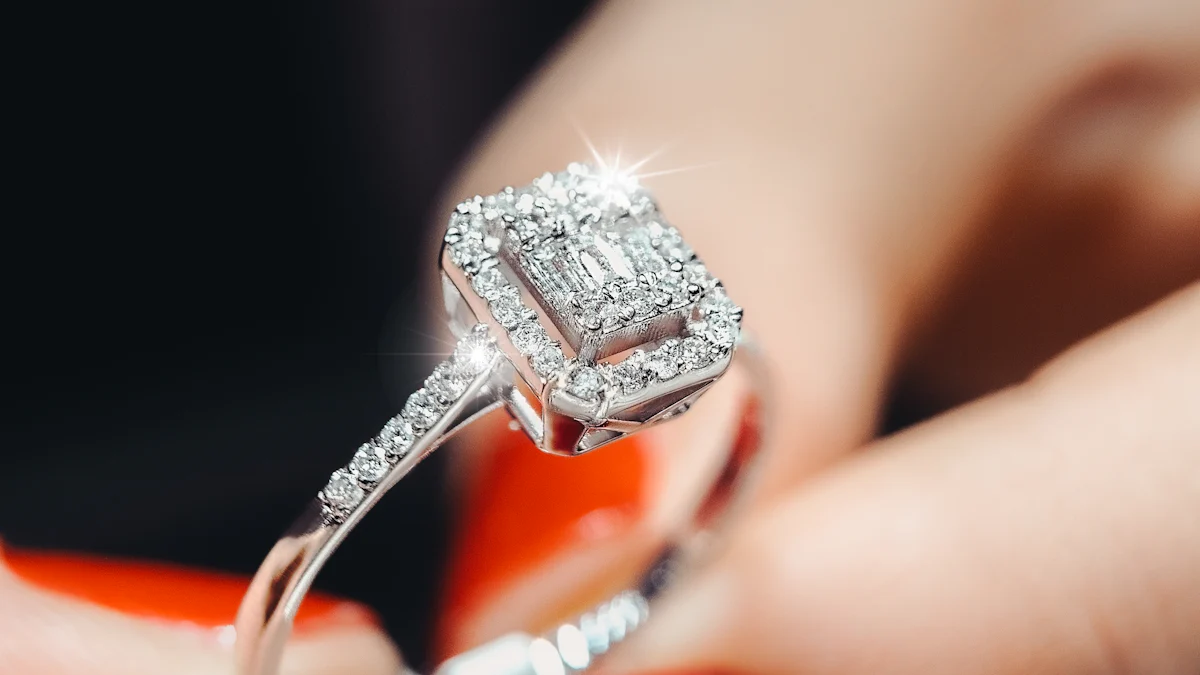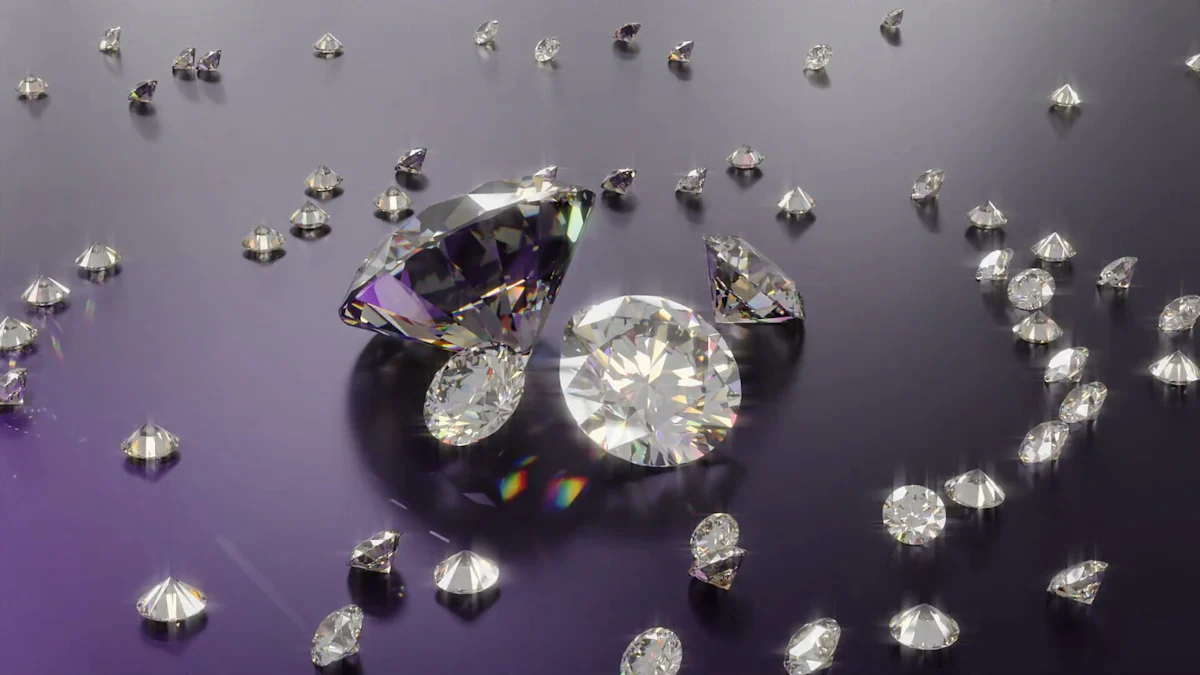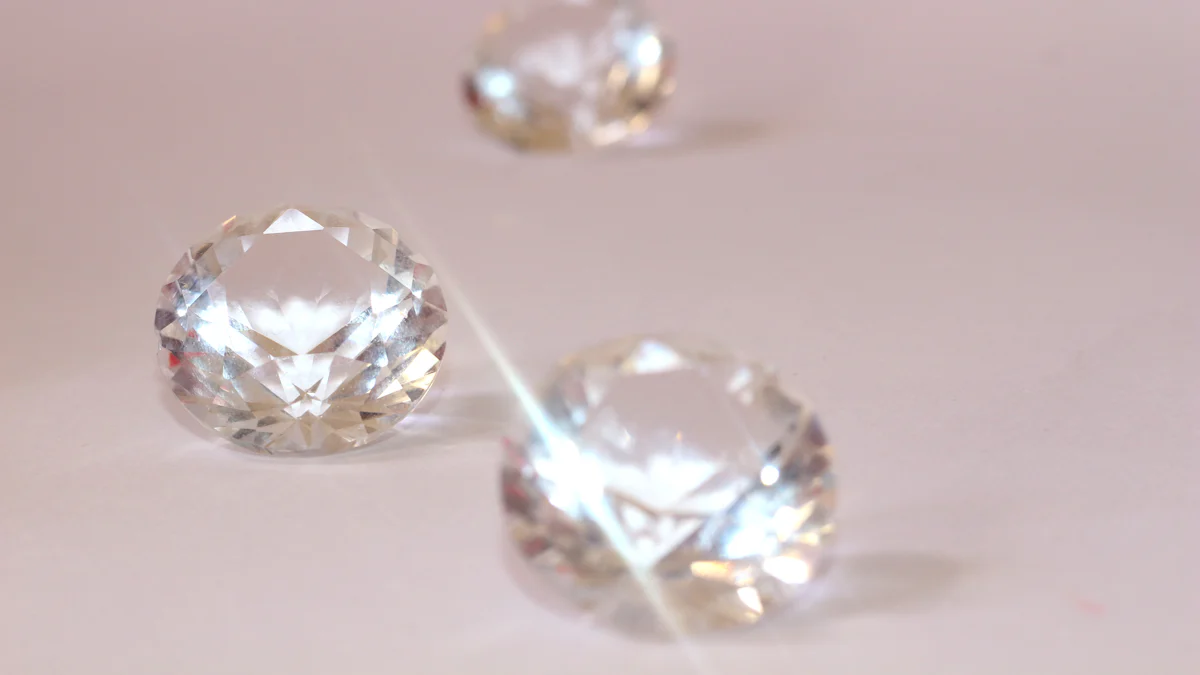Meaning of VVS Diamonds and Their Impact on Value

The meaning of VVS diamonds lies in their exceptional clarity. These diamonds rank high on the clarity scale, just below Flawless (FL) and Internally Flawless (IF) grades. VVS stands for "Very, Very Slightly Included," indicating inclusions so tiny that even experts struggle to spot them under magnification.
Clarity plays a vital role in diamond evaluation. It reflects the rarity and purity of a stone, directly influencing its value. Higher clarity grades, like VVS1 and VVS2, command premium prices due to their scarcity. A slight shift in clarity grade can significantly impact a diamond's worth.
VVS clarity enhances a diamond's brilliance and sparkle. Its near-flawless appearance makes it a top choice for those seeking beauty and value. Understanding the meaning of VVS diamonds helps you appreciate their unique qualities.
Meaning of VVS Diamonds and Their Clarity

Understanding the Diamond Clarity Scale
Overview of clarity grades from Flawless (FL) to Included (I)
The diamond clarity chart categorizes diamonds based on the visibility of internal and external imperfections, known as inclusions and blemishes. The scale ranges from Flawless (FL), where no inclusions or blemishes are visible under 10x magnification, to Included (I), where imperfections are easily noticeable even without magnification. Each clarity grade reflects the rarity and purity of a diamond, which directly impacts its value.
Where VVS diamonds fit on the clarity scale
VVS diamonds, or Very, Very Slightly Included diamonds, rank just below Flawless (FL) and Internally Flawless (IF) on the diamond clarity chart. These diamonds have inclusions so minute that they are extremely difficult (VVS1) or very difficult (VVS2) to detect under 10x magnification. Their position on the scale highlights their exceptional purity and rarity.
Characteristics of VVS Diamonds
Definition of 'Very, Very Slightly Included'
The term "very, very slightly included" refers to diamonds with inclusions so small that they are invisible to the naked eye. Even under magnification, these inclusions are challenging to spot, making VVS diamond clarity one of the most sought-after grades for its near-flawless appearance.
Types of inclusions found in VVS diamonds
The characteristics of VVS diamonds include inclusions such as pinpoints, needles, internal graining, or clouds. These inclusions are typically visible only through the pavilion or under a microscope. Unlike lower clarity grades, VVS diamonds lack noticeable imperfections like crystals, feathers, or cavities, ensuring their pristine look.
Assessing Diamond Clarity: VVS vs. Other Grades
Comparison with Flawless (FL) and Internally Flawless (IF)
When assessing diamond clarity, VVS diamonds differ from Flawless (FL) and Internally Flawless (IF) grades in subtle ways. FL diamonds have no inclusions or blemishes under 10x magnification, while IF diamonds may have minor surface blemishes. In contrast, VVS diamonds contain tiny internal inclusions, but these inclusions remain nearly imperceptible even under magnification.
Comparison with VS (Very Slightly Included) and SI (Slightly Included)
The difference between VVS1 and VVS2 diamonds and lower grades like VS or SI lies in the visibility of inclusions. VS diamonds have minor inclusions that are difficult (VS1) to somewhat easy (VS2) to see under 10x magnification. SI diamonds, on the other hand, often have inclusions visible to the naked eye. VVS diamonds stand out for their superior clarity, with inclusions that are nearly impossible to detect.
How VVS Clarity Affects Diamond Appearance

Visual Characteristics of VVS Diamonds
Why inclusions are nearly invisible to the naked eye
VVS diamonds stand out for their near-flawless appearance. The inclusions in these diamonds are so tiny that even under 10x magnification, they are extremely difficult to detect. This exceptional clarity ensures that no imperfections are visible to the naked eye, giving the diamond a pristine and polished look. Whether you’re admiring a VVS1 or VVS2 diamond, the optical purity remains unmatched, making these diamonds a top choice for those who value perfection.
How VVS clarity enhances brilliance and sparkle
The brilliance and sparkle of a diamond depend heavily on its clarity. VVS diamonds allow light to pass through without obstruction, creating exceptional brilliance and fire. Unlike diamonds with lower clarity grades, which may have inclusions that block or scatter light, VVS diamonds maintain their optical integrity. This clarity enhances their ability to reflect light, resulting in a dazzling sparkle that elevates their overall appearance.
Comparing VVS Diamonds to Lower Clarity Grades
Differences in appearance between VVS and VS/SI diamonds
When comparing VVS diamonds to VS or SI diamonds, the differences in clarity become evident under magnification. VVS diamonds have inclusions that are nearly impossible to detect, even with a jeweler’s loupe. In contrast, VS diamonds may have minor inclusions that are slightly easier to spot, while SI diamonds often have visible inclusions that can affect their appearance. To the naked eye, VVS diamonds appear virtually flawless, whereas SI diamonds may show imperfections that detract from their brilliance.
Situations where clarity differences are noticeable
The clarity differences between VVS and lower grades like VS or SI become noticeable in larger diamonds or under close inspection. For example, in diamonds over one carat, inclusions in lower clarity grades may become more apparent, especially in SI diamonds. If you’re choosing a diamond for a setting that emphasizes its center stone, such as a solitaire ring, the superior clarity of a VVS diamond ensures a cleaner and more radiant appearance.
Clarity and Diamond Buying: Other Factors to Consider
Why cut quality can enhance or diminish the impact of clarity
While clarity is important, the cut quality of a diamond plays a crucial role in its overall appearance. A well-cut diamond maximizes light reflection, enhancing its brilliance and sparkle. Even a VVS diamond can lose its optical appeal if the cut is poor. When buying a diamond, prioritize cut quality alongside clarity to ensure you get the most out of your investment.
The role of color and carat weight in overall appearance
Color and carat weight also influence a diamond’s appearance. A colorless diamond with VVS clarity will look brighter and more vibrant than one with a yellowish tint. Similarly, larger diamonds tend to showcase inclusions more prominently, making VVS clarity an excellent choice for stones with higher carat weights. Balancing clarity with color and carat weight ensures a diamond that meets your aesthetic and budgetary preferences.
How VVS Clarity Impacts Diamond Value
Pricing of VVS Diamonds
Why VVS diamonds are more expensive than lower clarity grades
VVS diamonds command higher prices due to their exceptional clarity and rarity. Their inclusions are so minimal that even under 10× magnification, they are nearly invisible. This level of purity makes them highly sought after. Compared to VS diamonds with similar characteristics, VVS diamonds can cost up to 40% more. Their scarcity further drives up their value, as only a small percentage of diamonds meet the stringent criteria for VVS clarity.
Factors that influence the price of VVS diamonds
Several factors contribute to the pricing of VVS diamonds. Their clarity grade plays a significant role, but other elements like carat weight, color, and cut quality also impact their cost. Larger diamonds with VVS clarity are particularly rare, making them more expensive. Additionally, the demand for VVS diamonds in the market ensures they retain their premium pricing over time.
Resale Value and Investment Potential
How VVS clarity affects resale value
VVS diamonds hold their value better than diamonds with lower clarity grades. Their rarity and superior clarity make them a desirable choice for resale. For instance, VVS diamonds are typically 20-30% more expensive than SI diamonds, and this price difference reflects in their resale value. While SI diamonds may be more affordable initially, their resale potential is significantly lower.
Long-term investment considerations for VVS diamonds
VVS diamonds are an excellent option for long-term investment. Their rarity and clarity make them a reliable store of value. They are less affected by market fluctuations, ensuring consistent demand. Over time, their value may appreciate, especially as high-quality diamonds become scarcer. Many investors view VVS diamonds as a stable asset, combining beauty with financial security.
Cost vs. Visual Benefit
Whether the price premium for VVS clarity is worth it
The decision to invest in VVS diamonds depends on your priorities. If you value exceptional clarity and rarity, the price premium may be worth it. VVS diamonds offer a near-flawless appearance that enhances their brilliance and sparkle. However, for those who prioritize size or color over clarity, a lower clarity grade like VS may provide better value without compromising visual appeal.
Alternatives for buyers on a budget
If VVS diamonds seem out of reach, consider alternatives that balance quality and cost. VS diamonds, for example, offer good clarity at a lower price point. In many cases, their inclusions are not visible to the naked eye, making them a practical choice. You can also focus on cut quality, as a well-cut diamond can maximize brilliance, even with a slightly lower clarity grade.
Pros and Cons of VVS Diamonds
Advantages of VVS Diamonds
Exceptional clarity and near-flawless appearance
VVS diamonds stand out for their exceptional clarity. Their inclusions are so minimal that they are nearly invisible, even under magnification. This clarity ensures a near-flawless appearance, making these diamonds a symbol of perfection. Their brilliance and sparkle enhance any jewelry piece, adding elegance and sophistication. Whether you’re choosing a diamond for a ring or a pendant, the aesthetic appeal of VVS diamonds guarantees visual pleasure.
High resale value and rarity
The rarity of VVS diamonds contributes to their high resale value. Their superior clarity and limited availability make them a sound financial investment. Over time, these diamonds often retain or even appreciate in value. If you’re looking for high quality diamonds that combine beauty with long-term value, VVS diamonds are an excellent choice. They also hold emotional significance, making them ideal for celebrating life’s milestones.
Disadvantages of VVS Diamonds
Higher cost compared to other clarity grades
VVS diamonds are significantly more expensive than diamonds with lower clarity grades. This price difference stems from their rarity and superior clarity. However, the visual differences between VVS and lower grades like VS or SI are often minimal. Without magnification, many lower-grade diamonds appear flawless to the naked eye, offering a more budget-friendly option.
Minimal visual difference from lower grades in certain settings
In practical settings, the clarity differences between VVS and lower grades like SI1 are less noticeable. Both can exhibit similar brilliance and sparkle when cut quality is prioritized. For buyers on a budget, opting for a slightly lower clarity grade allows for larger diamonds or better color quality without sacrificing overall beauty.
Who Should Consider VVS Diamonds?
Buyers prioritizing rarity and perfection
If you value rarity and perfection, VVS diamonds are an ideal choice. Their exceptional clarity and brilliance make them perfect for significant occasions like engagements or anniversaries. Collectors also favor these diamonds for their rarity and investment potential.
Buyers with a flexible budget
A flexible budget allows you to explore the full potential of VVS diamonds. You can choose larger carat weights or unique shapes while maintaining exceptional clarity. Lab-created VVS diamonds also offer a more affordable alternative without compromising quality. By prioritizing cut quality, you can maximize brilliance and achieve a stunning look within your budget.
Tips for Buying VVS Diamonds
Importance of Certification
Why GIA or AGS certification is essential
When buying VVS diamonds, certification from reputable organizations like GIA (Gemological Institute of America) or AGS (American Gem Society) is crucial. These certifications ensure the diamond's authenticity and quality.
- GIA provides detailed grading reports that differentiate between VVS1 and VVS2 diamonds.
- A GIA certificate verifies the diamond's value and guarantees it meets strict quality standards.
- AGS certification also offers clarity grading and ensures you avoid scams involving imitation diamonds.
Without proper certification, you risk purchasing a diamond that doesn’t match its advertised clarity grade. Always prioritize certified diamonds to protect your investment.
How to verify a diamond's clarity grade
You can take several steps to confirm a diamond's clarity grade before making a purchase:
- Examine the diamond closely using tools like a jeweler’s loupe or high-quality images from trusted vendors.
- Review the diamond’s certificate and clarity plot to understand its inclusions.
- Look for an eye-clean diamond, meaning no visible inclusions are detectable without magnification.
These steps help you confidently evaluate VVS diamond clarity and ensure you’re getting what you pay for.
Evaluating VVS Diamonds in Person
Tips for inspecting clarity under magnification
When evaluating VVS diamond clarity in person, use a 10x magnification loupe or microscope. Focus on identifying inclusions, which are often microscopic in VVS diamonds. Pay attention to the diamond’s pavilion and crown, as inclusions may be more visible in these areas. If you’re unsure, ask the jeweler to point out any inclusions and explain their impact on the diamond’s appearance.
Questions to ask jewelers about inclusions
When buying VVS diamonds, ask your jeweler specific questions about inclusions:
- Where are the inclusions located, and how do they affect the diamond’s brilliance?
- Are the inclusions visible without magnification?
- Can you provide a clarity plot or certification for this diamond?
These questions help you make an informed decision and avoid surprises later.
Balancing Clarity with Other Factors
Why cut, color, and carat weight also matter
While clarity is important, the other 4Cs of diamonds—cut, color, and carat weight—play a significant role in a diamond’s overall beauty. Cut quality has the greatest impact on brilliance, followed by color and clarity. Carat weight determines size but doesn’t always enhance visual appeal. Prioritize cut quality to maximize sparkle, even if it means choosing a slightly lower clarity grade.
How to prioritize features based on your budget
To balance clarity with other factors, focus on what matters most to you. If you’re on a budget, consider these tips:
- Choose a diamond that is eye-clean, even if it’s in the VS1-VS2 range.
- Avoid overpaying for higher clarity grades when lower grades offer similar visual appeal.
- Invest in a well-cut diamond, as it enhances brilliance regardless of clarity.
By prioritizing the right features, you can find a diamond that fits your budget without compromising on beauty.
VVS diamonds stand out for their exceptional clarity, rarity, and brilliance. Their near-flawless appearance makes them highly desirable, while their clarity grade significantly influences their value and visual appeal. When choosing a diamond, you should carefully assess clarity alongside other factors like cut, color, and carat weight.
Consider your budget and priorities to decide if VVS diamonds align with your needs. Opt for alternatives like VVS2 or lab-created diamonds if affordability is a concern. By balancing quality and cost, you can find a diamond that offers beauty and value.
FAQ
What does VVS mean in diamonds?
VVS stands for "Very, Very Slightly Included." It describes diamonds with tiny inclusions that are nearly impossible to see, even under magnification. These inclusions do not affect the diamond's brilliance or sparkle.
Are VVS diamonds worth the price?
VVS diamonds are worth it if you value rarity and near-flawless clarity. They offer exceptional beauty and hold their value well. However, for budget-conscious buyers, lower clarity grades may provide similar visual appeal at a lower cost.
How can you tell if a diamond is VVS?
You can confirm a diamond's VVS clarity by examining it under 10x magnification. Inclusions will be extremely hard to spot. Always check the diamond's certification from trusted organizations like GIA or AGS for accurate grading.
Do VVS diamonds sparkle more than others?
VVS diamonds sparkle more because their minimal inclusions allow light to pass through unobstructed. However, the diamond's cut quality plays a bigger role in enhancing brilliance and sparkle.
Should you choose VVS diamonds for an engagement ring?
VVS diamonds are ideal for engagement rings if you prioritize clarity and rarity. Their near-flawless appearance ensures a stunning centerpiece. For those on a budget, VS diamonds can also be a great choice.
See Also
Exploring Essential Elements That Influence Diamond Ring Costs
Exploring The Meaning Behind Eternity Diamond Rings
Comparing Different Styles of Diamond Necklaces by Cost

